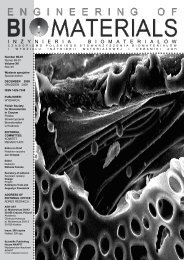69-72 - Polskie Stowarzyszenie BiomateriaÅów
69-72 - Polskie Stowarzyszenie BiomateriaÅów
69-72 - Polskie Stowarzyszenie BiomateriaÅów
Create successful ePaper yourself
Turn your PDF publications into a flip-book with our unique Google optimized e-Paper software.
Acknowledgement<br />
<br />
The research is supported by the Ministry of Education<br />
project: Transdisciplinary research in Biomedical Engineering<br />
II., No. MSM 6840770012.<br />
FIG.1.<br />
References<br />
[1] Daniel M., Sýkora J., Goldman T., Konvičkova S., New design of<br />
the acetabular component for total hip replacement., Biomechanics<br />
of Man, Spicak, 2004.<br />
[2] Daniel M., Sýkora J., Konvičkova S., Development of new design<br />
of the acetabular component for total hip replacement., Conference<br />
on Biomaterials in Medicine and Veterinary, Rytro, 2005.<br />
FIG.2.<br />
Degradable scaffold<br />
materials for cartilage<br />
regeneration<br />
Elżbieta Pamuła 1* , Aleksandra Polok 2 , Elżbieta Menaszek 3<br />
FIG.3.<br />
FIG.4.<br />
FIG.5.<br />
Discussion and conclusion<br />
Decrease of the contact stress gradient by way of modification<br />
of the non-weigh bearing area was succeeded. The<br />
maximal value of the contact stress was increased by the<br />
hole in the non-weigh bearing area. This value was on the<br />
edge of the hole. We substituted this stress concentrator and<br />
a cup margin by fillet edge. We tried to decrease maximal<br />
value of the contact stress by this trim. We tried to decrease<br />
enhancement of the contact stress by fillet edge. The maximal<br />
value of the contact stress was decreased by this fillet.<br />
The resultant contact stress distribution was not negatively<br />
affected by this trim. The results are in the Figures 1-5.<br />
The fillet inside edge of the cup and edge of the hole in the<br />
non-weigh bearing area was acquired more homogenous<br />
contact stress distribution. The contact stress distribution<br />
and maximal value of the contact stress is influenced by the<br />
different geometry of a contact surface. This fillet decreased<br />
maximal value of one third. We found out from comparison<br />
of results of the distribution of the classic cup that fillet edge<br />
did not influence gradient of the resultant contact stress<br />
distribution. The change geometry influence maximal value<br />
of the contact stress distribution only.<br />
1<br />
AGH-UST, Department of Biomaterials,<br />
30, Mickiewicza Al. 30-059 Cracow, Poland<br />
2<br />
Silesian Medical University,<br />
Department of Otolaryngology,<br />
10, M. Curie-Skłodowskiej str., 41-800 Zabrze, Poland<br />
3<br />
Jagiellonian University, Collegium Medicum, Faculty of<br />
Pharmacy, Department of Cytobiology and Histochemistry,<br />
9, Medyczna str., 30-688 Cracow, Poland<br />
*E-mail: epamula@agh.edu.pl<br />
Abstract<br />
Two scaffolding materials for cartilage regeneration<br />
were produced from poly(L-lactide-co-glycolide) (PLG)<br />
and PLG modified with sodium hyaluronate (PLG-<br />
Hyal). The scaffolds were characterized in terms of<br />
their microstructure and surface chemistry. Biological<br />
properties of the scaffolds were also evaluated by implantation<br />
of the scaffolds into auricular cartilage of the<br />
rabbits for 1 and 4 weeks. Histological and histochemical<br />
examinations show that both scaffolds promote<br />
regeneration of the cartilage, although the quickest regeneration<br />
was found after implantation of PLG-Hyal.<br />
[Engineering of Biomaterials, <strong>69</strong>-<strong>72</strong>, (2007), 3-5]<br />
Introduction<br />
Defects and diseases of cartilage (articular, nasal, aural)<br />
have been often treated surgically with the use of autografts,<br />
allografts or artificial biomaterials. For example in the treatment<br />
of auricular reconstruction silicone implants were the<br />
most frequently utilised, but they have gradually lost favour<br />
due to unacceptably high rates of infection and extrusion<br />
[1]. Recently porous polyethylene is the most widely used,<br />
because of its lower tissue reaction and better resistance<br />
to collapse [2]. It was shown that resorbable polymers such<br />
as polyglycolide and polylactide support chondrocyte adhesion<br />
and formation of cartilaginouslike tissue in dynamic<br />
conditions in vitro [3]. In order to better mimic the structure<br />
and composition of the cartilage extracellular matrix hyaluronic<br />
acid or hyaluronyan / polymeric scaffolds are also<br />
produced [4].













